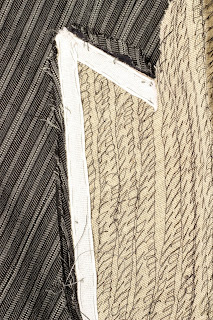
Francesco Smalto, pictured above, passed away last month.
I once had the opportunity to examine one of the coats made in his Paris atelier, and posted a video showing some of the work being done. Those who fetishize hand work should absolutely love his stuff, though the styling may not be for everybody.
Kirby recently reached out to me to offer another, more recent example of their work, Kirby of the Hanger Project, whose website sells luxury wooden hangers and Saphir shoe polish. Yes, I am willing to trade links for bespoke clothing.
This example was made for a member of the royal family of the country in which Smalto was residing when he passed away, and whose taste in clothing can be said to be somewhat flamboyant. A 3 on 3 double-breasted model with a huge amount of padding in the shoulders, and a rather firm chest, cut out of a stripe which we might normally associate with trousers to be paired with a morning coat. The photo below is of me modeling the coat.

Their house label set in their trademark teardrop pocket, one of the little touches that at once speak of uncommon attention to detail and an attempt at "luxury branding". The back of the pocket is also shown.


The bottom of the center vent is tacked by hand with the trademark S for Smalto, a little touch that I like.

Other details which are unusual to see in bespoke clothing but are typical of luxury houses are branded jacquard linings, and corozo buttons with FRANCESCO SMALTO etched in the back.

The client's initials are hand embroidered on the lining, in addition to the usual label inside the pocket with the client's name, order number and date of order (not shown).

The buttonholes, as expected, are good, but I have seen better examples of the boutonnière milanaise



The lining has been entirely inserted by hand with a semi-decorative stitch. Here is shown the inside of the vent.

Now for the more nerdy stuff.
As we saw on the last example, the top collar is done in two pieces, a bit of engineering not commonly found in bespoke tailoring.

All the seams have been overcast by hand, which is somewhat unusual as one might expect to find them either pinked or serged which would be much faster than doing it by hand. But I respect their choice. The lapel and collar, on the other hand, have been padded by machine, then the edges taped rather carefully by hand.


The chest, however, has been very thoroughly padded by hand on both sides.

An absolutely enormous amount of wadding in the shoulder but a light, single-ply piece of canvas in the cap of the sleeve-


And a very liberal amount of haircloth in the chest.

Students of tailoring should take note of the split, or vee, in the smaller piece of haircloth along the roll line- the fullness created by doing this is carried over the shoulder point, though this split is normally applied neck to the neck and not quite so far down the chest.
To avoid the vees we usually see in the shoulder part, the canvas has been seamed along the hollow part, not only to create the necessary length over the shoulder point, but to rotate the hairline in that part on to a semi bias. This creates some give over the shoulder but also some support- it is common to turn the haircloth piece in the shoulder on a similar angle. What is not clear to me is the purpose of the cross-cut piece of inch-wide haircloth running straight up the hollow part of the front shoulder. This may be due to a particular shape on the client's anatomy.

Very wide outlets have been left on the shoulder seam-

The back neck and armhole have been stayed with lining instead of silesia (or, as we will soon see from a Neapolitan tailor, canvas)


The vents are reinforced with wiggan, which has been felled, along with all the hems, with an extremely fine thread and a very delicate stitch. Someone in their shop has very good hands.

Overall the workmanship is excellent, with an inordinate amount of attention to detail overall, something which should lend Paris' tailors a much higher level of esteem on the world stage- by comparison, many of the better-known Italian houses are over-rated. But that will be the subject of another discussion, coming very soon, thanks to a long-awaited donation by voxsartoria...












